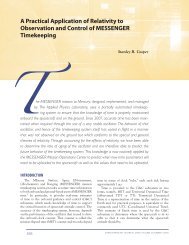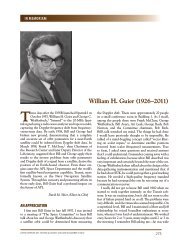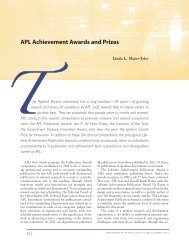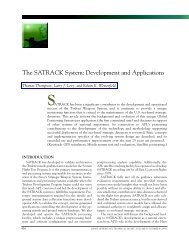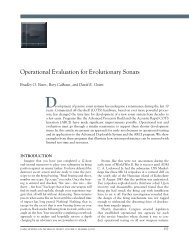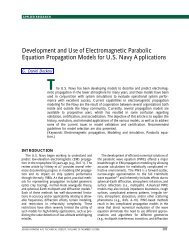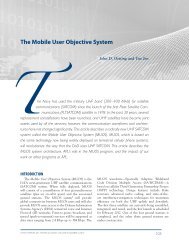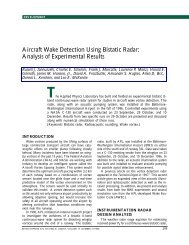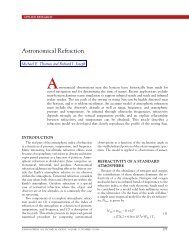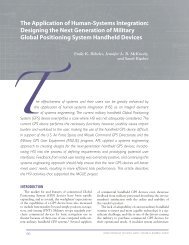The NEAR Mission: Guest Editor's Introduction - Johns Hopkins APL ...
The NEAR Mission: Guest Editor's Introduction - Johns Hopkins APL ...
The NEAR Mission: Guest Editor's Introduction - Johns Hopkins APL ...
You also want an ePaper? Increase the reach of your titles
YUMPU automatically turns print PDFs into web optimized ePapers that Google loves.
T. B. COUGHLIN<br />
event. <strong>The</strong> flyby was performed flawlessly by all elements<br />
of the <strong>NEAR</strong> team with excellent results. It was<br />
the most difficult of any flyby ever attempted, primarily<br />
because of the lack of definitive tracking of Mathilde<br />
until several hours before the flyby, which was<br />
accomplished at 10 km/s. <strong>The</strong> <strong>NEAR</strong> navigation team<br />
at the Jet Propulsion Laboratory played a significant<br />
role in this event, as well as throughout the development<br />
phase.<br />
<strong>The</strong> <strong>NEAR</strong> spacecraft was launched successfully on<br />
a Delta II 7925 vehicle on 17 February 1996, the<br />
second day of a 12-day launch window. <strong>The</strong> window<br />
each day was 1-min in duration. <strong>The</strong> launch was<br />
scrubbed on the first day because of range problems.<br />
To date, approximately eight small trajectory correction<br />
maneuvers and a major deep space maneuver have<br />
been performed. An Earth swingby will occur in January<br />
1998, and the <strong>NEAR</strong> spacecraft will finally arrive<br />
at Eros in January 1999.<br />
<strong>NEAR</strong>’s suite of instruments will provide the data<br />
needed to better understand this primitive asteroid.<br />
<strong>The</strong> instrumentation includes the Multispectral Imager,<br />
Near-Infrared Spectrometer, X-Ray/Gamma-Ray<br />
Spectrometer, Magnetometer, and Laser Rangefinder.<br />
<strong>APL</strong> played a significant role in the development<br />
of each instrument. In certain cases, the responsibility<br />
was shared with an industry partner or the<br />
Goddard Space Flight Center. <strong>The</strong> articles by Hawkins,<br />
Peacock et al., Goldsten, Lohr et al., Cole, and<br />
Hersman et al. discuss the development of the instrument<br />
suite.<br />
THE AUTHOR<br />
<strong>The</strong> articles by Hartka and Persons, Mosher and<br />
Wiley, Ercol and Krein, Jenkins et al., Strikwerda et<br />
al., Bokulic et al., Stott et al., and Burek discuss the<br />
spacecraft subsystems. <strong>The</strong> primary author of each<br />
article is the lead engineer of the subsystem discussed.<br />
One of the most satisfying aspects of the development<br />
phase was the significant cooperation of several<br />
<strong>APL</strong> Departments. <strong>The</strong> most notable effort was that<br />
of the Technical Services Department in the fabrication<br />
of the <strong>NEAR</strong> hardware. This work is described in<br />
the article by Dettmer, who led the fabrication effort.<br />
Whitworth et al. discuss the development of the<br />
<strong>Mission</strong> Operations Center, which had to be connected<br />
to the spacecraft during integration and test at <strong>APL</strong>,<br />
to Cape Kennedy during launch operations, to the<br />
Deep Space Network, and to the Science Data Center<br />
at <strong>APL</strong>. Finally, Heeres et al. provide a look at the<br />
Science Data Center. This facility was not needed to<br />
support the launch; its development will continue<br />
throughout the 3-year cruise phase.<br />
After the spacecraft arrives at Eros in January 1999,<br />
it will reduce its altitude above the surface from approximately<br />
100 km to 12 km over the 1-year orbital<br />
phase. Significant results are anticipated from this<br />
first-ever orbit of a small body. <strong>The</strong> <strong>NEAR</strong> science<br />
team, which includes people from many universities<br />
and government agencies across the country, is now in<br />
the final phase of planning the year at Eros. In February<br />
2000, the <strong>NEAR</strong> spacecraft will land on the surface of<br />
Eros, completing an extremely challenging mission.<br />
We look forward to the scientific rewards.<br />
THOMAS B. COUGHLIN holds a B.S.M.E. from the University of Maryland<br />
and an M.S.M.E. in aeronautical design from the Drexel Institute of Technology.<br />
He has served as <strong>NEAR</strong> Project Manager throughout the development,<br />
launch, and mission phase of this initial “faster, better, and cheaper” Discovery<br />
program. He is also the Programs Manager for <strong>APL</strong>’s Space Department. Mr.<br />
Coughlin has participated in several fast-track SDI programs, and for those<br />
efforts he was awarded the Distinguished Public Service Medal. His e-mail<br />
address is tom.coughlin@jhuapl.edu.<br />
94 JOHNS HOPKINS <strong>APL</strong> TECHNICAL DIGEST, VOLUME 19, NUMBER 2 (1998)




